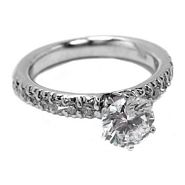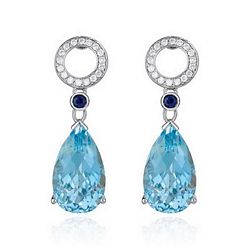Jewelry Repair Guide
NO ADSENSE ACCOUNT SELECTED FOR GOOGLE ADSENSE When it comes to fine jewelry, there are a number of things that can go wrong and when they do, the situation can instantaneously turn your happiness into loss. Loss as on altogether losing your precious diamond ring, diamond bracelet, diamond pendant, diamond solitaire ring, princess cut diamond or other fine jewelry.
Imagine waking up one morning and noticing one or more of your diamonds or precious gems are missing from their settings; it happens everyday! Or, going through your day and all of the sudden, you realize that your diamond watch or diamond engagement ring is no longer on your wrist or finger. You frantically search for your jewelry, but to no avail; it happens everyday and it happens to the best of us!
Remember Chris Evert? The former World #1 woman tennis player was wearing an elegant diamond bracelet while playing in the U.S. Open. Her bracelet inexplicably broke during the match and her diamonds went flying!
All most all of these jewelry mishaps and accidents can be avoided with proper care, inspection and maintenance of your fine jewelry. In this session I’m going to share 12 Jewelry repair tips that will save you time, money and aggravation.
Jewelry Repair Tip #1When it comes to fine jewelry, one simple way to minimize an unplanned mishap that can potentially ruin your day, is to have your fine jewelry inspected and evaluated periodically by a professional jeweler.
For most jewelry, every two to three months should suffice. However, if you constantly wear your jewelry while leading an active life, the frequency of these inspections should increase. Your jeweler can make that call upon inspection of your item(s).
Jewelry Repair Tip #2Perform your own inspections. Without question, the primary cause of lost gemstones is worn, thin or broken prongs or tips. In between your professional inspection, you should check to se if your gemstones are moving, rattling, crooked, cracked or out of place. Inspect each area around stones to see if settings are secure.
Use a toothpick or a pair of tweezers to gently nudge the gemstones to see if any of them move or wiggle. In some instances, compacted dirt under gemstone settings can actually give the appearance that the stones are snuggly fitting within the settings, when they are not. Usually, they become very loose and fall out when they are cleaned, so keep an eye out for those scenarios.
Jewelry Repair Tip #3Invest in a jeweler's loop; use it to determine the true condition of your fine jewelry in between your professional jewelry inspections. Check to see if your jewelry is becoming dull or worn.
If you have bracelets or diamond necklaces, examine the latches carefully. They should spring back instantaneously and should not be marred or damaged in any shape, form or fashion.
Jewelry Repair Tip #4 When it comes to finding a great jewelry repair shop, just know the first rule of thumb; all jewelers are not created equal! What than means is this, you can go to a store that belongs to a national chain and get great service at that particular store and terrible service at another store in that same chain.
In the same token, you can go to an independent jewelry repair shop and receive superior service and another independent jewelry repair shop and get horrible service. Go here to learn the 5 Rules to Finding a Great Jewelry Repair Shop.
|
Diamonds Are Forever
Buying Diamonds Guide | Diamond Rings | Diamond Earrings | Diamond Engagement Ring
Wedding Rings | Black Diamonds | Blue Diamond Ring | Diamond Bracelet | Tiffany Diamonds
Loose Diamonds | Fake Diamonds | Famous Diamonds | Bonded Diamonds | Colored Diamonds
Wholesale Diamonds | Platinum Wedding Ring | Diamond Solitaire Ring | Yellow Diamonds
Diamond Jewelry Resources
Jewelers Vigilance Committee | Gemological Institute of America | The Jewelers Board of Trade
American Institute Of Diamond Cutting
|
Blood Diamonds |
Stop Blood Diamonds
Join Stop Blood Diamonds |
Diamond Glossary |
Diamond FAQs |
Diamond Mine
The 4 C's of Diamonds | Diamond
Appraisal | Diamond Certificate
Fine Jewelry Resources
How To Find a
Great Jewelry Repair Shop | How To a Avoid Jewelry Repair
Fiasco | The Jewelry Repair
Guide
Man Made Diamonds
Apollo Diamond | CARAT
| Cubic Zirconia | Diamond Nexus |
Gemisis Cultured Diamond
Moissanite Jewelry | Russian
Diamonds | Swarovski Crystals |White
Sapphire
DIAMONDEXPERTS.BIZ is the leading diamond jewelry and fine jewelry resource on the Internet. We
provide up to date information on all types of diamonds and associated jewelry. Our primary mission is to help you
find the best deal possible on genuine diamond jewelry.
Copyright © Diamond Experts 1997-2012 All Rights Reserved.
Privacy Policy
Powered by the Buy Jewelry
Online
Diamond Experts
Diamond Cutters and Polishers, Goldsmiths, Top-Tier Designers and Diamond
Setting Masters
Antwerp Jewels & Diamond
Manufacturers
Antwerp / Belgium / Brazil / Canada / Europe / Italy / USA and
Worldwide



 Facebook
Facebook Twitter
Twitter Delicious
Delicious Livejournal
Livejournal Reddit
Reddit Stumbleupon
Stumbleupon Yahoo My Web
Yahoo My Web Google Bookmarks
Google Bookmarks BlinkList
BlinkList Digg
Digg Blogmarks
Blogmarks Diigo
Diigo Fark
Fark Ma.gnolia
Ma.gnolia Netvouz
Netvouz Newsvine
Newsvine Slashdot
Slashdot Spurl
Spurl Technorati
Technorati Wists
Wists